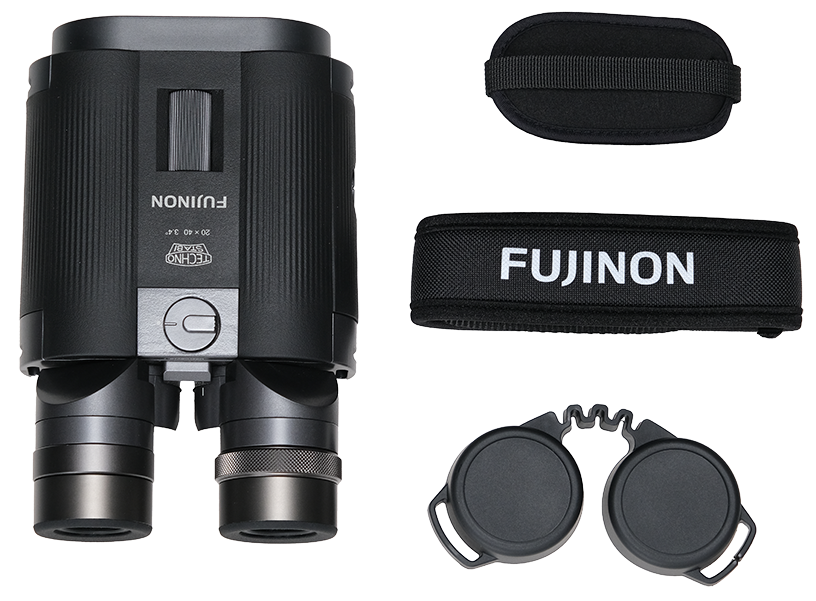Binoculars are grouped based on their focus type; CF (Center Focus) or IF (Individual Focus). Read below for a general overview of some basic features.
![[photo] Techno-Stabi Series TS16x28 Binocular](https://asset.fujifilm.com/www/mm/files/2023-09/00a0605d0ebbfdc8a3e3b93027fd3fe0/fig_howto_01.jpg)
TS16×28
- Eyepiece Lens・Eyecup
- Dioptric Adjustment Ring
- Focus Knob
- Binocular Body
- Objective Lens
- Strap Attachment
![[photo] MT Series 7×50FMTR-SX Binocular](https://asset.fujifilm.com/www/mm/files/2023-09/7bb1d04062afd95f3b8f190fb37b627a/fig_howto_02.jpg)
7×50FMTR-SX
- Eyepiece Lens・Eyecup
- Dioptric Adjustment Ring
- Diopter Scale
- Central Axis
- Objective Lens
- Strap Attachment
To ensure a clear view of your subject through binoculars, it's crucial to follow the correct preparation steps. Here, we'll explain the four essential steps you should take before looking through your binoculars:
- Eyecup Adjustment
- Interpupillary Distance Adjustment
- Focus and Dioptric Adjustment
- Proper Holding Technique

The eyecup is located at the binocular's eyepiece. By setting the eyecup position correctly and aligning your eye with the exit pupil (eye relief), you can view the entire field of vision without any distortions. There are two types of eyecups, each with different adjustment methods.
![[photo] eyeglass wearers (folded)/non-eyeglass wearers (extended)](https://asset.fujifilm.com/www/mm/files/2023-09/7b035d8eed593e9923451d2330820a3a/pic_howto_02.jpg)
Fold the eyecup of the binoculars to the fully folded or extended position.
![[photo] eyeglass wearers (shortened)/non-eyeglass wearers (extended)](https://asset.fujifilm.com/www/mm/files/2023-09/8578c7e79588aff271ed5a311b62152d/pic_howto_03.jpg)
Rotate the eyecup to adjust its height. The click mechanism allows you to find the ideal position easily.
![[photo] Step 2: Interpupillary Distance Adjustment](https://asset.fujifilm.com/www/mm/files/2023-09/9f8d114f7ee9d418f701a70a61451059/pic_howto_04.jpg)
Interpupillary distance varies between individuals and refers to the distance between their pupils. Move the binocular's hinge to adjust the binoculars for your specific interpupillary distance.
![[photo] Luminous flux (Exit pupil)/Blackout](https://asset.fujifilm.com/www/mm/files/2024-06/0074f870ee907bdd259d4b8459b63321/pic_howto_05.png)
To check for correct adjustment, adjust until the image circles in the view align and merge into a single image circle.
![[photo] OK/blackout (darkening)](https://asset.fujifilm.com/www/mm/files/2023-09/4b3d6ebc0e229ebc71fe382ea4ee0239/pic_howto_06.jpg)

Note: In binoculars with a smaller exit pupil diameter, even a slight misalignment between the optical axis and your pupils can cause blackout (darkening) of the image.
To obtain a sharp image, both focus and diopter adjustments are necessary. People often have different visual acuity in their left and right eyes. Without adjusting the diopter, the image will be in focus for one eye but not the other, resulting in a blurry and unclear view. There are primarily two focus mechanisms, each with its own adjustment method.
- Look through the left eye and adjust the focus knob located in the center of the binoculars until the view is clear.
- Look through the right eye and adjust the diopter of the eyepiece lens until the view is clear.
- With both eyes, look through the binoculars. If set properly, the image should be sharp and clear, and the diopter should not need to be set again.
- Rotate the dioptric adjustment rings on both eyepieces separately to align the focus for each eye.
- With both eyes, look through the binoculars. If set properly, the image should be sharp and clear. When using binoculars to view objects at different distances, you will need to adjust each eye's focus independently.
![[photo] Step 4: Proper Holding Technique Bad/Good](https://asset.fujifilm.com/www/mm/files/2023-09/201d2392e57b14110ae61132f068e191/pic_howto_09.jpg)
- Hold the binoculars firmly with both hands, but avoid gripping them too tightly as it may cause your hands to shake. If you won't be moving the binoculars while using them, using a tripod can help prevent any shaking or blurriness.
- Place the eyepieces against your eyes, rest your elbows against your body, and look through the binoculars without raising your arms. To prevent dropping the binoculars, make use of the strap provided.

- If there are trees, a stand, or a wall nearby, you can lean against them or rest your elbows on them to reduce shaking or instability.
- If there is a landmark or object near your target, first locate the direction of your target and the landmark using your naked eye. Then, use the binoculars to observe the landmark while searching for and adjusting your focus on the target.

Let's take the TS-L 1640 as an example. The basic installation method is the same for other models.
- A hand strap can only be attached to the TS-L series.
- A neck strap and a hand strap cannot be attached at the same time.
- Place eyepiece caps, rings and a neck strap in the order shown in the photo.
- Pass the rings and the eyepiece caps through the neck strap as shown in the photo.
- Pass both ends of the neck strap through the left and right strap attachment points (common to neck and hand strap) on the binoculars in the order shown in the photo.
- As shown in the photo, pass the left and right sides of the neck strap through the rings and eyepiece lens cap, respectively and then pass them through the neck strap fastener.
- Pull the neck strap one by one to remove any slack. Adjust until the neck strap is balanced on both sides and is the right length. Finally, pull the neck strap tightly to make sure the fasteners are secure.
- When not using the eyepiece caps, remove the strap on the side with the notch.
- When using a hand strap, pass it through the hand strap attachment point on the objective lens side of the binoculars as shown in the photo. The hand strap can be attached to either the left or right side.
- Pass the hand strap through the pad as shown in the photo.
- Pass the hand strap through the strap attachment point (common to neck and hand strap) on the eyepiece side of the binoculars as shown in the photo.
- Pass the hand strap through the hand strap fastener as shown in the photo.
- Adjust the hand strap to a comfortable length before use.

Here you will find a list of terms used in binoculars and information about the specifications table









